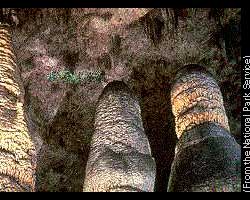ACIDOPHILES

Highly Acidic Cave

Sulfuric Geyser

Sulfuric Hot Spring
Most natural environments on the earth are essentially neutral, having pH values between five and nine. Acidophiles thrive in the rare habitats having a pH below five. Highly acidic environments can result naturally from geochemical activities (such as the production of sulfurous gases in hydrothermal vents and some hot springs) and from the metabolic activities of certain acidophiles themselves. Acidophiles are also found in the debris left over from coal mining. Interestingly, acid-loving extremophiles cannot tolerate great acidity inside their cells, where it would destroy such important molecules as DNA. They survive by keeping the acid out. But the defensive molecules that provide this protection, as well as others that come into contact with the environment, must be able to operate in extreme acidity. Indeed, extremozymes that are able to work at a pH below one--more acidic than even vinegar or stomach fluids--have been isolated from the cell wall and underlying cell membrane of some acidophiles.
*Have you heard of a stalactite? What about a stalagmite? Yes, no maybe? I remember learning of them this way; when walking through a cave, one might trip over a stalagmite, but holding tight to the cavern wall, a stalactite will not fall. It now seems we have a new "tite" to become familiar with. A snot-tite...

Mmm...Snot-tite